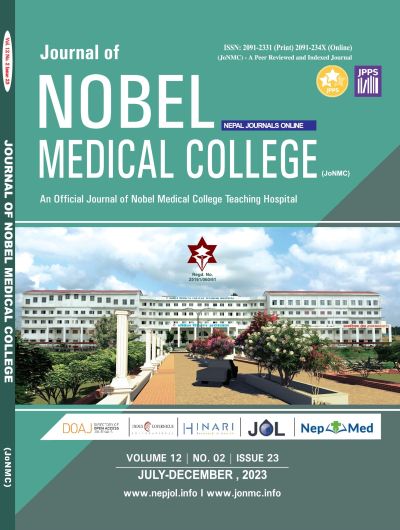Pelvic Floor Dysfunction and Quality of Life among Hysterectomy Cases at B.P. Koirala Institute of Health Sciences
DOI:
https://doi.org/10.3126/jonmc.v12i2.61354Keywords:
Body mass index, Hysterectomy, Prolapse, SymptomsAbstract
Background: Pelvic floor dysfunction a global major female reproductive health burden associated with genitourinary and psychosocial symptoms even after hysterectomy has been underreported in the developing world. The study aimed to determine the early incidence of pelvic floor dysfunction and its psychological impact among post-hysterectomy women.
Materials and Methods: It was a prospective cohort study for 52 weeks among 130 post-hysterectomy cases at the tertiary care center. Pelvic floor dysfunction was diagnosed with the Pelvic Floor Disability Index and quality of life with the Pelvic Floor Impact Questionnaire. The association of pelvic floor dysfunction with epidemiological characters was analyzed using SPSS version 20.
Results: The incidence of pelvic floor dysfunction was 7.8% and the impact on the quality of life was 2.7% among 130 post-hysterectomy cases. Age, body mass index, comorbidities like chronic obstructive lung disease, and previous abdominal surgery were statistically significant. A parity of three or more, caesarian sections with instrumental delivery and Transabdominal hysterectomy was statistically significant with pelvic floor dysfunction and Socio-Psychological effect within the same groups of patients. The most common symptoms were urinary symptoms accounting for 9(90%) followed by prolapse 5 (50%) and colorectal 4(40%) with a score of 20.82± 9.07, 7.48±4.5 and 6.97± 1.55, and quality of life was mostly impacted by bladder symptoms 3 (100%) with a score of 24.96±2.96.
Conclusion: Pelvic floor dysfunction is a common health burden among post-hysterectomy cases especially with older age, higher Body Mass Index, Chronic Obstructive Pulmonary Disease, parity of more than three and caesarian sections with instrumental delivery.
Downloads
Downloads
Published
How to Cite
Issue
Section
License
Copyright (c) 2023 Subhadra Agrawal, Tulsa Basnet, Baburam Dixit, Aparna Hegde, Mohan Chandra Regmi

This work is licensed under a Creative Commons Attribution 4.0 International License.
JoNMC applies the Creative Commons Attribution (CC BY) license to works we publish. Under this license, authors retain ownership of the copyright for their content, but they allow anyone to download, reuse, reprint, modify, distribute and/or copy the content as long as the original authors and source are cited.




